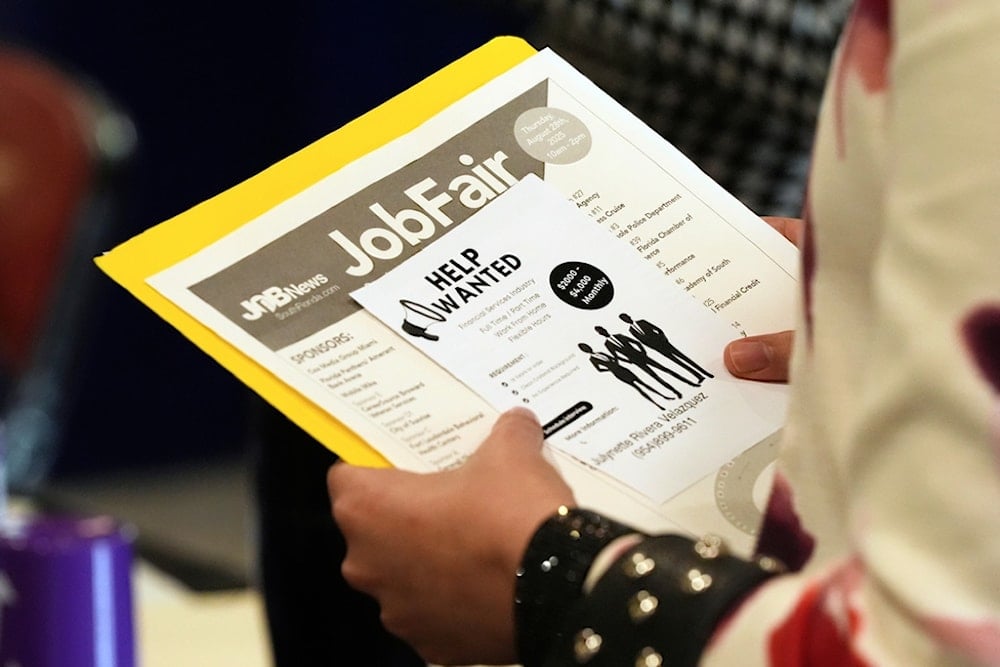Trump's immigration curbs may cut 15 million US workers by 2035
A new study warns that US President Trump's restrictive immigration and trade policies could shrink the US workforce by over 15 million by 2035, slowing GDP growth, raising debt, and deepening structural labor shortages across key sectors.
-

A job seeker waits to talk to a recruiter at a job fair Thursday, Aug. 28, 2025, in Sunrise, Fla. (AP Photo/Marta Lavandier)
Axios on Saturday reported that a new study projects President Trump's intensified immigration policies could dramatically shrink the US labor force in the coming decade, with ripple effects across the economy.
According to the National Foundation for American Policy (NFAP), workforce numbers may decline by 6.8 million by 2028 and 15.7 million by 2035 as a result of ongoing deportations, restrictions on both legal and illegal immigration, and new limits on refugee admissions and international student programs. The report warns that such reductions could dampen economic growth, raise federal debt, and exacerbate labor shortages in industries like manufacturing, healthcare, and agriculture.
Of the projected 2028 decline, around 2.8 million workers would be lost due to legal immigration policy changes, while 4 million would result from stricter enforcement against undocumented immigrants. The study also noted that approximately one-third of the overall decline through 2035 would stem from restrictions on legal immigration pathways.
President Trump has expanded US Border Patrol and Immigration and Customs Enforcement (ICE) operations, prioritizing the removal of undocumented individuals, including those previously granted temporary protection after fleeing war, persecution, or natural disasters. His administration also halted refugee admissions, implemented a 2025 travel ban, and restricted foreign student employment.
White House spokesperson Abigail Jackson defended the approach, stating that Trump's agenda seeks to "capitalize on untapped potential" while enforcing the law. "There is no shortage of American minds and hands to grow our labor force," Jackson said, adding that over one in ten young adults are currently neither employed nor in education or training.
In April, Trump signed an executive order to "modernize American workforce programs to prepare citizens for the high-paying skilled trade jobs of the future." However, the study cautioned that such measures will not offset the loss of millions of foreign workers. It estimates that the enforcement policies would reduce annual GDP growth by about half a percentage point between 2025 and 2035 and increase federal debt.
The analysis does not account for the added economic impact of limiting access to high-skilled foreign workers, a policy shift economists say could further slow productivity and innovation. Meanwhile, the administration's goal of deporting one million immigrants per year would exceed any historical precedent, potentially worsening the projected decline.
Broader Economic Outlook Under Trump
The NFAP projections coincide with broader warnings from economic institutions that Trump's policies, particularly his tariff agenda and immigration restrictions, could reshape the US economy in ways that constrain long-term growth.
The Congressional Budget Office (CBO) estimates that expanded tariffs could shrink real GDP by about 0.6% by 2034 and raise inflation by roughly 1% by 2026, as higher import costs feed through to consumer prices. The International Monetary Fund (IMF), while recently upgrading its US growth outlook to around 2% for 2025, cautioned that continued trade friction and labor shortages could erode competitiveness over time.
Analysts at Deloitte similarly forecast that business investment will remain resilient in the near term but warn of a slowdown to about 1.4% growth by 2026, before a modest rebound later in the decade. They attribute this dip to supply constraints, tariff-related costs, and a tightening labor pool exacerbated by lower immigration.
Economists also note that the administration's record deportation targets and protectionist trade policies could disproportionately affect sectors dependent on foreign labor, including construction, energy, and agriculture, driving up wages and production costs, and potentially fueling inflation.
Structural Challenges Ahead
Experts argue that while Trump's strategy of boosting domestic training and manufacturing jobs could bring short-term employment gains, the demographic reality of an aging population means the US cannot sustain economic expansion without immigrant labor. With fertility rates at record lows and baby boomers exiting the workforce, many economists view immigration as the only realistic engine for maintaining workforce growth.
The NFAP warns that unless legal migration pathways are reopened, the US could face chronic worker shortages, declining productivity, and a widening fiscal gap as the ratio of workers to retirees shrinks. Combined with trade frictions and rising debt, this could place the US economy on a slower long-term trajectory, one defined less by domestic self-sufficiency than by structural scarcity.
Read more: US economy shows warning signs of stagflation return, Trump to blame

 4 Min Read
4 Min Read








